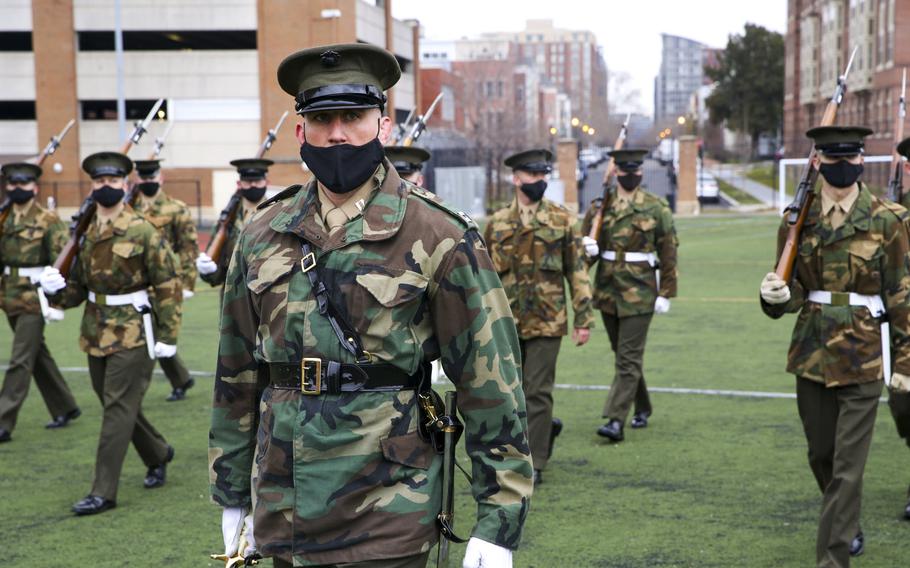
Marines with Marine Barracks Washington prepare for the upcoming Presidential Inauguration, Washington, D.C., Jan. 5, 2021. The Marines are wearing an unusual combination of a Vietnam-era field jacket in woodland camouflage with their khaki-and-olive green service dress uniforms. (Tanner D. Lambert/U.S. Marine Corps)
The Marines preparing for Inauguration Day ceremonies wore black face masks, white gloves — and an unusual combination of a Vietnam-era field jacket in woodland camouflage with their khaki-and-olive green service dress uniforms.
Photos of the uncommon ensemble — made stranger by the fact that the Corps transitioned to digital camouflage nearly two decades ago — drew a number of “what are they wearing” comments on social media.
“A sad day in Marine uniforms when we look dumber than the Army,” Marine veteran Pete Lucier wrote on Twitter.
It turns out the style is unique to the historic Marine Barracks Washington, home to the service’s elite ceremonial units.
The jacket is a little more rugged for practice sessions than the formal uniform coats that Marines wear in ceremonies. But it won’t be seen at events on Jan. 20, when Joe Biden is sworn in as the 46th President.
“The Field Jacket is primarily worn to simulate the Dress Blue jacket,” said Andre Bastian, a Marine veteran who spent five years at the barracks, also known as 8th & I. “It can only be worn with service B and C (short and long sleeve) and only during official barracks practices.”
Barracks Marines use many tricks and unusual modifications to make their outfits look their best for ceremonies at places like Arlington National Cemetery and high-profile events in the capital. But the field jacket is supposed to be worn as-issued, Bastian said.
Originally produced in olive drab, the cold weather field coat was added to the military inventory in 1966 and became available in the woodland pattern in 1982, according to a 2007 study by David C. Cole, a former curator at the U.S. Army Center of Military History, Museum Division.
Designed for utility, and commonly known as the M65 field jacket, it's also become something of a style icon, available as a designer knock-off for $500 from Polo Ralph Lauren — about five times what it costs from a military surplus store online.
The field jacket’s rough similarities to the blues coat allow a Marine to place the formal uniform’s belt at the right height to practice fixing and unfixing a bayonet to his M1 Garand rifle, which is also a throw-back.
“The move itself is tricky, and requires precision and a little bit of luck,” said Bastian, an infantryman who served at the barracks from late 2014 to mid-2019. “If you put your scabbard on your belt line — you’d be practicing a few inches off, and you’d get nowhere.”
It's also helpful for officers and noncommissioned officers who practice ceremonially drawing and sheathing their swords.
“Yeah, it looks really weird from the outside looking in,” Bastian said. “But it’s quite practical!”
garland.chad@stripes.com Twitter: @chadgarland